Henkel He.162 Salamander
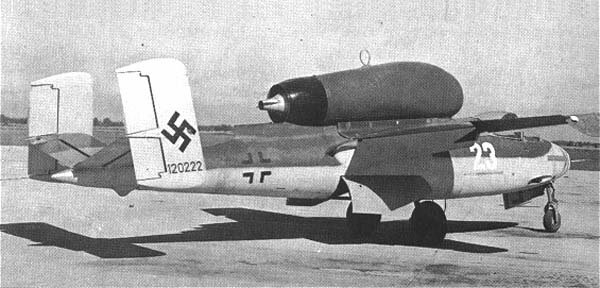
Perhaps the most exciting history the creation of any combat aircraft will be the story of the so-called "Folksgeere" - "people's fighter" - the plane conceived, designed and built in just 90 days! The idea of "Folksgear" was born in the mind of the chief of the "fighter headquarters" Otto Zaur - protege of the Minister of Armaments Albert Speer. It was planned to create a simple, cheap fighter, suitable for mass production from cheap materials and using low-skilled labor.
8 September 1944. the technical department prepared the basic requirements for such an aircraft and sent them to Aradot and Blon und Foss. "Fizeleru", "Focke-Wulf", "Heinkel", "Messerschmitt" and "Junkers". Volksyager had to have one VMW-003 “Sturm” turbojet engine, weigh no more than 2000 kg, carry armament from one or two 30-mm guns, reach speeds of 745 km / h, have a flight duration of 30 minutes and take-off distance in 500 The plane should have been prepared for serial production by 1 in January, 1945 g, and draft designs should be provided for 20 in September, 1944.
Adolphe Galland was sharply opposed to this project, who demanded that the German aviation industry be given up on releasing the proven Me. 262. He was supported by such authoritative designers as Messerschmitt and Tank, who believed that the task itself and the conditions for its implementation were unrealistic. But, despite this, it was proposed to reduce the time frame for the provision of draft designs for six days - until September 14!
On 15 September RLM convened a conference following a preliminary review of the projects. Messerschmidt refused to provide anything for the competition at all, and Focke-Wulf presented a clearly unrealistic project. The project "Arado" was rejected, the proposal of "Heinkel" was considered difficult to implement. The project "Blom und Voss" was recognized as the best. Heinkel was represented at the conference by one of the directors, Franke, who was told that their proposal was rejected for five reasons: a) the flight duration was only 20 minutes; b) inconvenient to maintain engine layout; c) the requirements for take-off distance were not met; d) the plane was too long to be transported by rail; e) guns had a caliber of only 20 mm.
Franke protested, arguing that the weight calculations and the determination of flight data for the contestants were carried out according to a method different from that used by Heinkel. As a result, the next day other projects were recalculated according to the Heinkel formulas. 19 September at the next RLM conference all proposals were revised, including the projects "Arado", "Blom und Foss" and "Heinkel", as well as the new "Fizelera", "Focke-Wulf", "Junkers" and "Zibel". Again, the winner was the "211 project", "Blom und Voss," which was superior in most aspects to other competitors. The meeting ended in a fierce skirmish between the director of the main committee on aircraft, the former general manager of Heinkel, Fridag, and the fliger-staffing engineer Schwarz, who represented the interests of Blom and Foss. As a result, no decision was made.
Despite the lack of an agreed solution, at the September 23 conference at Goering’s headquarters in East Prussia, the start of serial production of the Folksäger was fundamentally approved. At the same time, the head of the engineering department Lyucht inspected the layout of the Heinkel aircraft in Schwechat. Chief Designer Karl Schwarzler and the chief engineer of the project worked on a similar aircraft at the beginning of summer, planning to create a small, uncomplicated fighter jet, which they called the Spitz (Sparrow). To evaluate its possible flight data on the He.219-V14, a VMW-003 turbojet engine planned for installation on the Spitz was tested in flight. In this case, with the He.219-V14, the ventral fairing was removed and the engine was installed on a short pylon. Flight tests began in July 1944 in Schwechat.
Gunther and Schwarzler did a great job of fine-tuning "Spitz" on the requirements of the Folksäger. Most of those working on the “1073 project” didn’t move away from their drawing boards even at night, staying to sleep right behind the drawing boards. Although no official choice has yet been made, political considerations have prevailed over technical differences. So Zaur has already decided that the Heinkel project is his “people's fighter”. Goring, who tasted the very concept, gave him full support. As a result, the production of the P.24 began on September 1073. In this case, the aircraft assembly and the development of drawings went in parallel.
Another RLM conference took place on September 30. By this time, it was announced that the Heinkel project had been chosen. After the protests of Schwartz and other members of the committee, the meeting again turned into a furious squabble. Especially zealous Lyuht. In order to finish the question once and for all, we decided to ask the opinion of the professors of the aerodynamic research institute Bets and Kuchemann, who suggested that there might be some difficulties with the aerodynamics of the air intake on the project "Blom and Voss" R.211. This put an end to the discussion. It was decided to start production of the "1073 project" with the monthly release of 1000 aircraft.
The Heinkel fighter was originally called He.500, but in October, to conduct enemy reconnaissance, the Technical Department assigned the aircraft the designation He.162 — this number was originally worn by a high-speed Messerschmitt bomber competing with Ju.88. At the same time, the aircraft received the nickname "Salamander", which was originally the designation of the entire program.
The full development of the drawings of He.162 ended on October 29 - a day earlier than the plans of the Technical Department. The first prototype was almost ready. In history aviation It is an unprecedented fact that the development of drawings, the assembly of an experimental aircraft and the preparation of mass production went simultaneously. Under He.162, three assembly lines were planned at Heinkel-Nord in Marne and Junkers-Mittelwerk at Nordhausen (with a general production plan of 2000 cars per month). These assembly lines were to be equipped with units from entire complexes of related industries. All wooden parts were to be produced at two specially created groups of woodworking plants in Erfurt and Stuttgart. Metal fuselages were to be produced at the Heinkel plants in Barthe (Pomerania), Lutnitz (Mecklenburg), Stassfurt (Saxony) and Oranienburg near Berlin, as well as at the Junkers plants in Schönbeck, Aschersleben, Leopoldshald, and Leopoldshald. The BMW-003 engines were to be produced in salt mines near Urseburg, where plants from Berlin-Spandau and Bezdorf-Zelsdorf were transferred.
Another salt galleries were re-equipped under the Salamander program in Egeln and Tartun, where fuselages were produced. All design work and the construction of a pre-production lot were carried out in Schwechat. The Schwechat plant was included in the mass production program along with an underground plant in a gypsum mine near Vienna. The entire program was governed by a special project group - the "Schulepp baugroup" headed by Heinrich Lübke. The first thousand He.162 planned to finish in April 1945 g, and in May to release 2000 aircraft.
Series He.162a
The fuselage of the He.162 was a monocoque light alloy with a wooden nose cone. The one-piece wing was mostly made of wood with plywood paneling and metal tips. The wing was attached to the fuselage by four bolts. Between the fuselage and the ailerons were flaps with hydraulic control. When flaps were released, the ailerons also deviated by 18 °. The plumage and rudders were light alloy, with the exception of the wooden keel. The stabilizer had a small transverse V, and its installation angle varied from + 3 ° to -2 ° by the deviation of the tail cone. The chassis, which had a narrow base, was removed in the fuselage.
The VMW-003 “Sturm” turbojet engine was mounted directly on the fuselage, behind the cabin. It was fastened in front with two vertical bolts, and at the rear - horizontal. Front and rear hoods attached directly to the engine. The central part of the hood consisted of two opened panels for quick access to the engine during inspection and maintenance. The normal fuel supply consisted of 700 l in one soft fuselage tank and one additional tank in the wing on the 180 l. Refueling was single point. The turbojet engine had a two-stroke Riedel starter, triggered by an electrical switch from the cab. The drop-shaped cockpit lantern opened back. The pilot was located on the simplest ejection seat with a pyrotechnic charge. The chair had straps modeled on Shutton, and on a parachute in the seat cup there was an emergency supply of oxygen. The oxygen system included a cylinder on the left side of the cabin and a pressure gauge in front of the pilot. On the right was engine management, speed indicators, fuel consumption, oil pressure, exhaust temperature and thrust. There were also electrical and radio switches. Radio equipment included the respondent FuG-25a, the simplest radio compass "Lorenz" FuG-24. The latter was designed only for 5-10 hours of operation - especially for the He.162, since this aircraft was not allowed to have more “life”. The transmitter and receiver had separate antennas on the left and right keels, respectively. Radio compass direction finder mounted on the engine. FuG-25 aerial was also in the left keel.
A magnetic compass FK-38 and the standard Revi-16G sight were mounted on the plane (although the Revi-16В was mounted on many airplanes). The sight was right in front of the pilot. According to the demand of the RLM, the plane was supposed to get two MK-108 guns on the sides of the cockpit, but a strong return and the inability to place ammunition more than 50 projectiles on the barrel, made it necessary to return to the original weapons proposal of two MG-151 / 20 with 120 shells on the barrel .
The first experienced He.162-V1 flew 6 on December 1944 in Schwechat under the control of the flug-captain Peter. By that time, serial production with the 12-hour two-shift work was almost unfolded. During the 20 minute flight. The 162-V1 reached 835 km / h speed at 6000 m, but the flight had to be stopped, as the landing gear niche that had a defective hinge opened in the air. Despite some instability on the course, Peter reported that the controllability of the aircraft was satisfactory. But four days later, during a demonstration in front of representatives of the RLM, the Luftwaffe and the Nazi party, during an unplanned speed passage over the airfield, the leading edge of the right wing collapsed, the aileron broke off, the plane went into uncontrolled rotation, fell and exploded. Peter died.
A study of the wreckage showed that the cause of the disaster was poor fasteners, but this did not delay the implementation of the Salamander program. To eliminate possible doubts after the crash with the He.162-V1, the next He.162-V2 on the first flight was the director Franke himself. In the first flight of December 22 and in subsequent Franke showed limit flight data on the aircraft. Later He.162-V2 was used for fire tests of a pair of MK-108. At the same time, the He.162-V3 was modified to test these two machines. To move the center of gravity slightly forward, a counterweight was placed above the nose wheel. To improve the stability of the wing tips received an inverse V-shape. Similar improvements were made on the fourth experienced He.162-V4. Both aircraft flew 16 January 1945.
Despite the Ferzuh numbers, the prototypes were also considered part of the installation batch of Schnechat 10 machines. At the same time, under Hinterbruhl, we started production of He.162a-1. He.162-V5 was used for static tests. V6 flew 23 January 1945 g. It was the last aircraft equipped with MK-108 guns. The V7 was already a prototype of the serial He.162a-1 and was tested on a shaker, which led to some strengthening of the structure. V8 was used to test the newly installed guns MG-151 / 20. V9 and V10 were similar to the previous one.
At the end of January, a whole team of testers was involved in the “Salamander” program, including Povolka, Bader, Shyukka, Meshkat and Wedemeyer. A series of machines for various tests was laid in Hintsrbruhl. Almost simultaneously with the factory in Hinterbruhl, its first He.162 released Heinkel-Nord in Marien. After assembly, ground test, shooting weapons and the acceptance tests of most of the aircraft assembled in Mariena came to Ludwigclust, Parchim and Rechlin. All He.162, collected in Hinterbruhl, were tested at airfields near Vienna. Each plant gave its aircraft numbers. So He.162, first assembled in Mariena, had factory number XXUMX 120, in Hinterbruhl No. XXUMX 001, and Junkers factories gave numbers starting with 220 001, 300 001 and the like.
Airplanes assembled in Hinterbruhl were mainly used for various tests and were given Ferzuk numbers. The first and second serial machines that flew 24 and 28 on January 1945, received the designation He.162a-2. They had a couple of guns MG-151, and instead of the engine BMW-003-1 was put VMW-003-1. The aircraft also had the designation He.162-V18 and V19 and were used for rather lengthy tests. The remaining Ferzuh numbers (excluding the unlucky 13) were assigned to subsequent aircraft released at Hinterbruhl. Usually they got the numbers in reverse order. So He.162-V11 and V12 were 17-m and 18-m production aircraft. They received the Jumo-004D engines and were considered prototypes of the A-8 series. He.162-V14 and V16 were used for static tests. He.162-V16 and V17 were prototypes of the two-seater training glider He.162s. They were shot turbojet engine and equipped with a second cabin with a double control for the instructor. Both cabins were closed with one lamp. He.162c had an elongated wing spanning 8.2m and an area of 13.8 sq.m. The keel was extended, the chassis was fixed, the wheels received fairings, the total weight was 1300 kg, and the maximum speed at the dive reached 420 km / h.
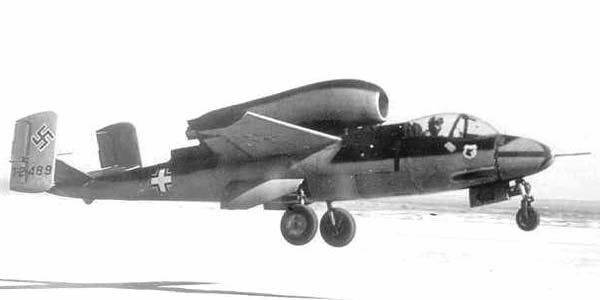
The third aircraft launched at Hinterbruhl received a simpler landing gear. Under the designation He.162-V20, he flew 10 February 1945 g. The fourth aircraft was used for fire tests under the designation He.162-V21, the fifth, which flew 25 February 1945 g, He.162-V22 - received a thickened sixth wing and sixth wing, sixth and sixth and sixth and sixth. .162-V23 and V24 were used for tests whose purpose is unknown.
The eighth and ninth production aircraft were prototypes of the He.162a-6, which had an elongated fuselage (from 9.05 to 9.2m). Armament consisted of two guns MK-108. Airplanes were also designated as He.162-V25 and V26. The first of them flew 17 February 1945g. The following two aircraft - V27 and V28 were made as doubles of previous machines. The twelfth and thirteenth aircraft were used to test weapons. The first of them, He.162-V29, flew 18 in February, and the second - V30 - 24 in February. The latter received a new sight "Adler".
The next half dozen planes also had queen numbers. Two of them as prototypes of He.162a-9 received engines ВМW-003R - combined with a liquid-fuel rocket engine. It was planned to release them under the designation He.162e-1. Another version of the series A - He.162a-14 had a number of changes in weapons and equipment. In addition to the standard weapons of a pair of guns MG-151 or MK-108, the installation of the so-called "15er wabe" or "SG Rohrblocktrommel" was proposed. The first was a package of 15 launchers for missiles R4M. Two such cassettes were mounted under each wing. The total weight of the four cassettes was 250kg. The launch of the R4M rockets was carried out at 70 millisecond intervals. Theoretically, the rate of fire was 3400 "shots" per minute. The second system was an option SG-117 - installation of a block of seven 30-mm gun barrels MK-108. There were seven shells in each barrel. None of these weapons options really tested on the He.162.
The only variant of the Folksäger that was produced in sufficient quantities was the He.162a-2, which almost immediately replaced the assembly lines A-1. Tests of short-barreled MK-108 - the main armament of He.162a-1 revealed the vibration of structural elements due to strong recoil. As a temporary measure, the aircraft was rearmed onto MG-151 / 20. The name has changed to He.162a-2. A pair of MG-151 with 120 shells on the barrel weighed only 121kg, and the gun MK-108 - 215kg. This made it necessary to place in the nose in order to maintain the centering, 60-kg counterweight. MK-108 guns were planned to be put on the He.162a-3, for which his fuselage should have been strengthened, but in reality this option was not produced.
Externally, the He.162a-2 practically did not differ from the experimental machines, with the exception of a larger wing area (up to 11 sq. M) due to large ailerons, and an increased sweep span (from 2.65 to 3.4). VMW-00З-1 engine was already replaced in production with VMW-00ЗE-1 and Е-2, which, with the same thrust at maximum - 800kg, could develop 30 kg for 920 seconds with increased fuel consumption from 1.61kg / kg * h to 1.96kg / kg * h However, the lack of VMW-XNUMHЗЕ forced to consider the possibility of installing the engine Jumo-00D.
The 162a-8, which did not go into the series, should have a take-off weight of 3110 kg with a 1030 liter of fuel. With Jumo-004D 930 kg, the speed was expected 880 km / h at the ground and 882 km / h at the height of 6000 m. The engine at full throttle at the consumption of 570 l fuel could work at the ground for 15 minutes and 40 minutes at the height of 12000 m or 28 minutes at the ground and 77 at a height of 12000 m at a flow rate of 1030 l. With a take-off weight of 2823 kg, the He.162a-8 should have gained 6000 m in 5.3 minutes and in 6.3 minutes with a weight of 3110 kg.
Further development
From the very beginning of the Salamander program, the designers of Heinkel planned to install the Heinkel-Hirt engine 011А (HеS-11А) on the aircraft, although it was not yet completed. The first model with "Heinkel-Hirt" was called He.162b-1. Start its mass production planned with 1946 g. The design was similar to the series A. The length of the fuselage was increased to 9.5 m, fuel supply - 1425 l. The armament was planned from two MK-103 guns with 100 shells per barrel. Wingspan and wing area were increased to 7.6 m and 11.9 sq.m. With the Heinkel-Hirt 011A engine 1300 kg with take-off weight 2500kg, ground speed was expected to 875 km / h. However, it was decided to release only nine pre-production HeS-011A-0, and none of them was intended for the program "Salamander".
Studies were also carried out on the installation of one or two Argus-Rohr impulse engines on a series B glider. These simplest impulse engines were completely unsuitable for installation on a fighter, and their use on the Folksager was considered by the designers of the Heinkel to be very skeptical. But the situation for the Third Reich was such that even the most unusual proposals were considered. From the very beginning of the Salamander program, the Luftwaffe considered He.162 as a degenerate. Their views were shared by the majority in the Technical Department. And only the strong pressure of the party leader and the head of the “fighter headquarters” Zaur could penetrate the request to install the Argus Rohr engines on the H. 162.
The plane would suffer from the strongest vibration. In addition, an additional launch system was required, the fuel consumption was very large - everything was against such a "hybrid". But He.162 with a pulsating engine was considered primarily as an anti-aircraft missile, controlled by the pilot. Such "disposable" aircraft planned to build quickly and in large quantities. This tried to solve the problem with the engines for the He.162.
Since the aircraft of the B series should have a larger supply of fuel, providing at least the minimum acceptable flight duration, Heinkel offered two options based on it: one with two pulsating Argus As-014 engines 330 kg, the other with one As -044 Kg xnumx. The first option involved the installation of two "Argus" on the back of the fuselage next to each other. In the second case, one engine was mounted on the back, immediately behind the main spar. For both options provided wing with tanks for 500 l fuel.
With two As-014 fighter weighed 3300 kg, and with one As-044 - 2900 kg. A rather optimistic estimate of flight data was given: maximum speed - up to 800 km / h (705 km / h with As-044) near the ground; 775 (655) km / h at an altitude of 3000, 705 (600) km / h at an altitude of 6000 m. The duration of the flight was estimated at 20 (21) min, and 37 (44) min, at an altitude of 6000 m. The speed was expected to be low - in fact, the H. 162 with pulsating engines was considered a low-altitude interceptor. There were several ways to launch such an aircraft, including using the Madelung KL-12 catapult and towing vehicles, but the option with launch missiles was chosen. Since Heinkel himself did not particularly hope for this model of aircraft, the work did not go further than the drawings. As a result, the three airframes dedicated to this project were not equipped with pulsating engines.
A further development was to be the He.162c, which combined the He.162b glider and the Heinkel-Hirt 011 engine with a swept (38 °) wing and V-shaped plumage tested on the He.280-V8. The new wing had the appearance of a “seagull” with a break on two thirds of its span. The wingspan was 8 m, the area 12.3 sq.m. With a normal take-off weight of 2520 kg, the speed at 6000 altitude m was estimated at 905 km / h. It was also developed in parallel with the He.162d with the reverse sweep wing. The emergence of such a wing was a step forward - it provided the same critical Mach number as the straight swept wing, but the breakdown on it occurred at lower speeds, which made it possible to have a thinner profile. The wingspan of the He.162d was to be 7.2m, the area was 11.5Sq.m, and the length of the aircraft was 9.8 m. Both the He.162c and D were short-range interceptors. It was planned to equip them with a pair of MK-103 on a special installation, which allowed to tilt the trunks upward at a slight angle. Although such a setup - one of the options for “shrage music” - was not really tested, it should have served to fire at the target, flying with some excess in relation to the interceptor. Neither He.162c nor He.162d were built, but when the Allies occupied Schwechat, they found a half-finished model for the HeS-11А engine with interchangeable forward and reverse sweep wings.
Another variant of the Folksäger, the He.162e, appeared even earlier with C and D. It was the production version of the He.162a-9 with combined engines VMW-003R, and brought to the flight model. VMW-003R was a conventional VMW-003A 800kg coaxial, paired with a VMW-718 rocket engine 1225 kg. Despite the problems with ensuring the sealing of rocket fuel tanks on prototype aircraft, it was believed that by the time of the mass production of the He.162e at the beginning of summer 1945, all difficulties could be overcome. He.162e had 450l fuel for the turbojet and up to 1200kg rocket fuel. It was assumed that at a speed of 800 km / h at a height of 10000, the turbojet engine would develop thrust to 280 kg, and rocket to 1400 kg. Take-off weight was estimated at 3835 kg, which gave a load on the wing 340 kg / sq. But the expected speed to 1005 km / h on the ground (0.82М) and 960 km / h at the height of 10000 m (0.81М). The takeoff run and climb to the height 90 took 24 seconds. Rise to a height of 5000 m - 1 min 57 sec. When using a rocket engine only for climb, and turbojet for horizontal flight, the duration of stay in the air was estimated at 25 minutes at a height of 5000 m, 43.8 minutes at a 10000 m, rate of climb - 85 m / s at the ground and 105 m / s at a height of 5000 m
Fighting career
25 September 1944. Hitler issued an order to form a "Volkssturm" under the leadership of Reichsführer SS Himmler. Goering, in order not to be left behind, decided to rely on the Folksager to create the air parts of the Volkssturm. An urgently convened meeting with Colonel-General Keller - the head of the National Socialist Air Corps and with the Reich Youth Guard Arthur Aksmann last assured Goering that he will receive pilots for thousands of "Folksäger" already assembled in factories. It was decided to send members of the Hitler Youth to glider schools, after which they had to sit directly in the Folksäger booth! One can only imagine what fantasy world possessed the minds of the leaders of the Third Reich, if Goering seriously believed that a transfer from a glider to a jet fighter would require only a minimum of flying time, and the final training of pilots would take place in combat units.
Before the Folksager had to enter the Volkssturm, he should have been checked in the Luftwaffe combat units. By tradition, the specially created test unit was the first to receive the He.162. At the end of January, 1945. Lieutenant Colonel Heinz Bar was appointed commander of the 162 test team or Folkger Commando in Rechlin. Over the next three months, Bar's team conducted military trials of the He.162 in Rechlin, and then in Munich.
At the same time, at the 6 technical school in Näinmarkt and Weidenburg, they began training staff. The honor of the story of the first in the battle "armada" folk fighters was given 1 th fighter squadron of Colonel Herbert Ilefeld. By the end of January, the squadron was on the Eastern Front. 6 January 1945 d. I / JG.1 received an order to surrender the FN.190 to the 2 group and head to Parchim for rearmament on He.162. Here, 60 kilometers from Heinkel-Nord in Marien, I / JG.1 staff began training under the direction of test pilots. Since the summer of 1944, I / JG.1 had four squadrons in it, but a week after arriving in Parchim, the 4-I squadron was disbanded and the staff was distributed among the three others. I / JG.1 stayed in Parchim for nine weeks, where the squadron headquarters joined her. Then the group was transferred to Ludwigslust - 20 kilometers south-west. Simultaneously, in Mariena, II / JG.162 arrived directly from the assembly line to receive the He.1.
Six days after arriving at Ludwigclust, I / JG.1 was again transferred this time via Husum to its military base in Lekk, Schleswig-Holstein. Lekk, originally a secondary airbase, became the gathering place for most of the remaining Luftwaffe units. The units were divided into three "divisions" (two "aviation" and one "fighter"), including the Ar.234 of I / KG.76. All of them literally crowded around the runway and in the surrounding fields. Service and supplies were catastrophically inadequate. As a result, I / JG.1 was virtually non-capable.
Complete collapse and confusion were reflected in the highest command. Even before the arrival of I / JG.1 in Lek, Hitler handed over the entire program of jet planes to the SS. Led by Obergruppenführer Kammler - "the main authorized representative of the Fuhrer on jet aircraft." Goering, who was neglected, rather resourcefully appointed Major General Kammhuber, the former head of the night fighter aircraft, to be "special representative for jet aircraft." All this brought even greater chaos in the management of the "Folkgers".

Meanwhile, II / JG.1 persistently mastered the new technology, but on April 24 its commander Dane died on the Baltic coast near Rostock. By the end of the month, the Red Army approached Rostock, and the training in Mariena had to be interrupted. At the same time, in the south, the Americans approached Munich. By this time, Bar’s testing team had joined JV.44 - the elite part of Adolf Galland with Me.262. After the injury of Galland, Bar entered the command of JV.44, and then evacuation from Munich followed. Me.262 and He.162 were transferred to Salzburg, where 3 May all the planes were destroyed, so as not to fall into the hands of the allies.
On the same day, Colonel Infeld’s headquarters and the remains of II / JG.1, commanded by Major Pober, arrived in Lek. On the next day of May 4, as a result of a general reorganization, all He.162 were consolidated into one large group. She was named Einshatz-Gruppe I / JG.1. The group had three squadrons and 50 He.162. In the last days of the war in Europe, pilots from other units, such as III / KG.30, disbanded on April 11, were sent to this group because of the failed rearmament plans on Me.262. But the lack of fuel and lack of time did not allow to bring He.162 to combat readiness.
It is possible that the Allied pilots from time to time encountered single H.162, but there are no exact data on possible battles with Folksagers - the H.162 pilots tried to avoid them, having a strict order to first master the new aircraft well. About 120 He.162 were officially accepted by the Luftwaffe, another 50 were taken from the factories without any formalities. By the end of the fighting around 100 He.162 expected acceptance flight tests, and more than 800 were in the final assembly stage.
As for Goering’s initial plans for the massive attacks of the manned Folksgeormen “Folksägers”, the only mention of a real attempt to bring this nonsense to life was a brief record of the formation of the first and only squadron of Folksturtm with He.162 - 1. (Volkssturm) /JG.G.G. in Zagen-Kupper.
He.162 was not an airplane for beginners. Due to the upper engine installation the aircraft was unstable in pitch. It was not a very pleasant machine to operate, requiring careful pilot piloting. The first rule that the learner learned from the H.162 pilot was: "Always work smoothly with a pen - no sudden movements, no sharp maneuvers!" Experienced pilots had to undergo serious training in order to adapt to such a fighter and develop the necessary "aircraft sense". Even if they had difficulties, one could imagine how unrealistic the attempts to put 16-year-olds from the glider schools after a short flight course into a very unstable, small aerodynamic freak.

Performance characteristics:
Year of adoption - 1945
Wingspan - 7,02 m
Length - 9,03 m
Height - 2,60 m
Wing area - 11,1 m2
Weight, kg
- empty aircraft - 1660
- normal takeoff - 2600
- maximum take-off - 2800
Engine type - 1 RD ВМW-003Е-1
Thrust, kgf
- rated - 800
- afterburner - 920
Maximum speed km / h
- near the ground - 885
- at height - 900
Practical range - 970 km
Maximum rate of climb - 1400 m / min
Practical ceiling - 12000 m
Crew - 1 pax
Armament: 2 guns MG-151 / 20 with 120 shells on the barrel.
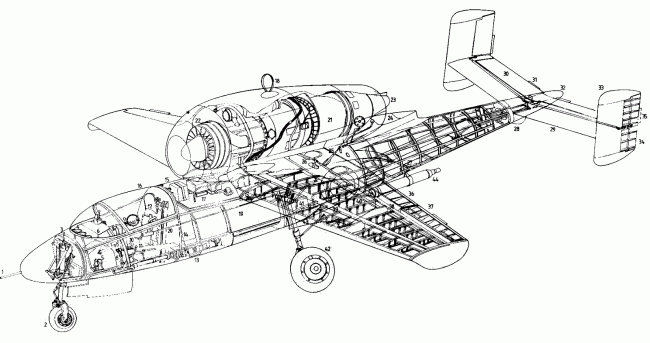
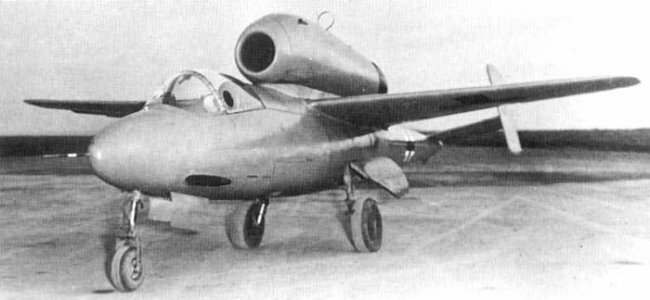
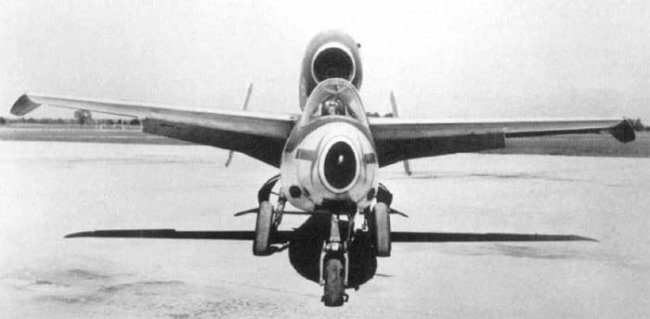
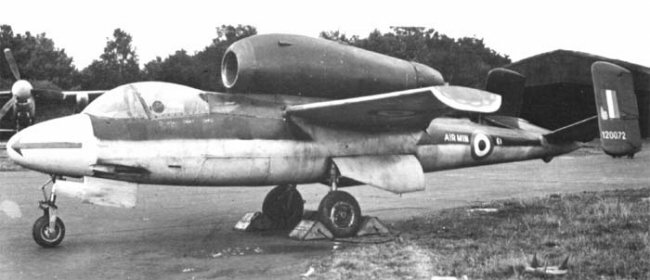
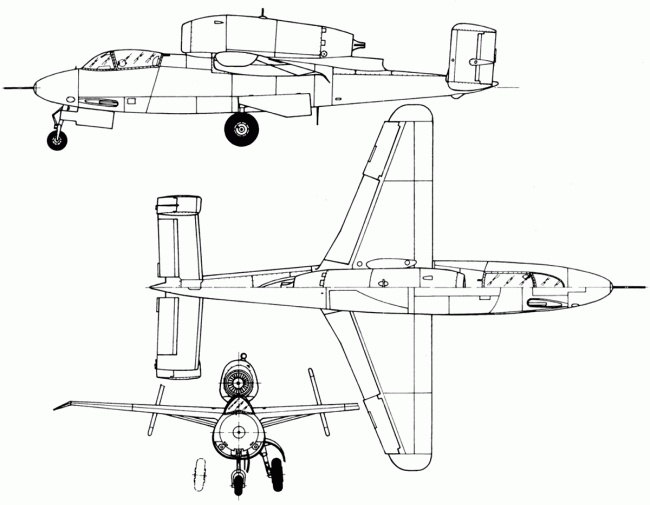
Information